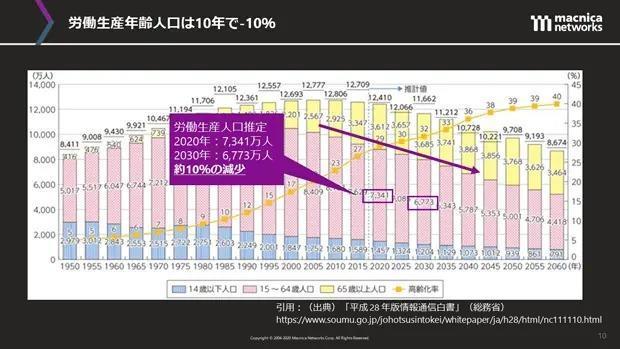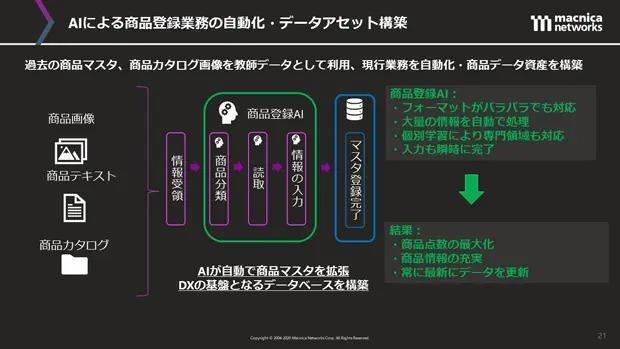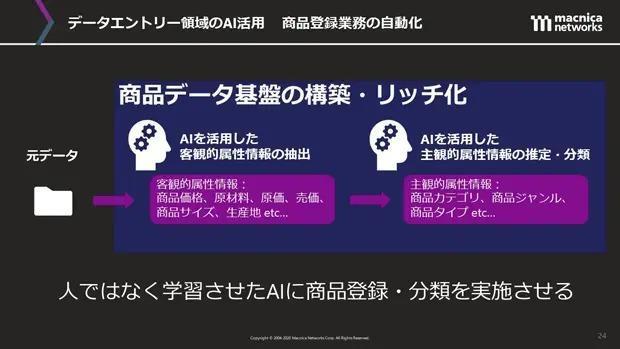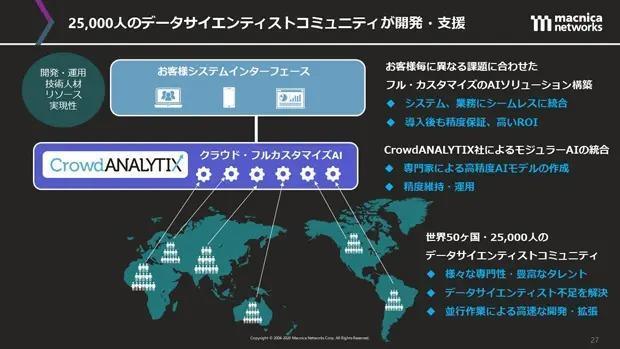Product data construction essential for successful retail/EC DX ─ Mr. Hirahara Macnica networks explains automatic registration using AI
Biz/Zine Day 2020 Autumn Report Vol.3: Macnica Networks Corp. Ikuma Hirahara

In order to improve the customer experience in the age of digitalization, DX and the enhancement of product data and customer data that form its foundation are essential. However, with the declining working population becoming a major issue, automating product registration operations using AI is an effective way to incorporate data without manpower. Mr. Ikuma Hirahara of CrowdANALYTIX's AI business department explained the integration of CrowdANALYTIX in 2019 and the company's AI product registration solution provided by a community of 25,000 data scientists around the world, based on an example of a major US retail company. .
DX to survive the era of 10% decrease in working population
As we all know, the biggest common issue facing Japan in the future is the declining birthrate and aging population. The working-age population is expected to decline by about 10% in 10 years, and there is no doubt that it will have a major impact on the retail industry, regardless of industry.
Looking at the population trends in Japan since 1950 compiled by the Ministry of Internal Affairs and Communications, as of 2020, the working-age population between the ages of 15 and 65 is about 73 million. In 10 years, in 2030, the number will decrease to 67.73 million, and the labor force will decrease by 10%. A company with 1,000 employees would need to operate in the same way with 900 employees in 10 years and expand its business. There is a possibility that each task will have to be carried out with a 10% reduction in the number of people.

“If the working-age population declines, the domestic resources that companies can use will also decrease, but this does not mean that companies should simply reduce their sales. There aren't many companies that are doing this," Hirahara warns.
Of course, companies are not the only ones who are concerned about the declining working population. The government is also looking for solutions to the problem, and one of them is "DX (Digital Transformation)". In 2018, the Ministry of Economy, Trade and Industry issued the ``DX Report-Overcoming the IT System ``2025 Cliff'' and Full-Scale Development of DX-'' and presented specific promotion measures as ``DX Promotion Guidelines''. The Ministry of Economy, Trade and Industry also proposes that “in order to confront the problem of a declining working population in Japan as a whole, it is necessary for companies to work together and actively promote DX.”
In order to realize DX, it is necessary to transform the “business model itself” by utilizing data and digital technology. It is possible to win domestic and international competition only by realizing data-driven efficiency and productivity improvement by utilizing technology instead of existing methods. Mr. Hirahara once again emphasized, "It is necessary to quickly formulate a medium- to long-term plan for DX and put it into practice."
Building a foundation for product and customer data that should be given top priority in retail DX
While the DX reform was called out, the explosive epidemic of the COVID-19 had a big impact. Initially, it was expected to converge early, but it is inevitable that the impact will continue in the future. The retail industry is one of the industries most affected by the Covid-19 pandemic, and even if it ends soon, it won't be the same as it was in the past.
In the future, it is necessary to think about business on the premise that the situation called "new normal" will continue. Everyone uses shopping apps on their smartphones, and web conferences, remote seminars, and remote work have become commonplace at work. Under such circumstances, the new life centered on "stay home" is based on new technologies such as online distribution, and the corona crisis has dramatically accelerated the use of digital on the user side.
"What we used to buy at stores has been replaced by digital purchases due to the corona crisis. Companies can't respond to changes in customer needs immediately, so changes may be gradual, but no one must start thinking, 'What should we do now?'" Hirahara said. Of course, if companies do not respond quickly, they risk losing customers. In order to respond to customer needs that have changed due to digitalization, it is necessary to redefine the value provided and channels while incorporating digitalization. However, it is difficult to replace them all at once. So where should we start?
Mr. Hirahara cited "building a data infrastructure" as the highest priority in DX. Nothing can start without data to promote DX. Therefore, it is important to have a system to continuously acquire "product data" and "customer data", which are important data for retail.
Mr. Hirahara said, "The first thing to do is to build a solid data infrastructure that will be the axis of DX, and to prepare a system that can update and manage data. It is important to realize that with a hybrid of technology and people. As improvements in each value chain on that foundation, he cited measures such as "optimizing the product lineup using digital technology," "demand forecasting that does not rely on intuition on the spot," and "personalized marketing."
"By applying it little by little, the value chain itself will change, and as a result, it will be possible to transform the retail business. DX is not an initiative to temporarily increase productivity. It's an effort to transform. As a foundation for that, we need to solidify the foundation from the part of creating data."

The high degree of completion of the product database creates purchasing opportunities
Regarding product data, it is important to "how well the data of the products handled by the company can be retained". Among them are "objective attribute information" that anyone can understand, such as product prices and raw materials, and "subjective attribute information" that reflects people's tastes and sensibilities, such as product categories and genres that differ from company to company. There is information. Customer data includes “quantitative data” such as age and gender, and “qualitative data” such as questionnaire responses and social media posts. After introducing these two, we will dig deeper into the automation of the process of creating "product data".
For example, let's say you're in a sporting goods store and your basic product data is in the product master. If customer A wants "new, low-cut sneakers in a color that does not look like other people's shoes," it is not always easy for her to find a product that matches her needs. This is because it is not possible to provide information that matches Mr. A's detailed needs with general product master data. However, if this product data is expanded to include information such as "low cut opening, rubber sole, city star style, 2020 release", you can find it and appeal to Mr. A. In other words, the completeness of the product database determines the creation of future purchasing opportunities and the success or failure of the DX that continues.
Mr. Hirahara said, "It's important to think carefully about how to create a data infrastructure, but we can't put a lot of manpower into it, and we need to increase the amount of data. We have to think about solutions to these conflicting issues." "Hyper automation" was mentioned. By combining AI and RPA technology, it is a method of having software robots carry out work instead of humans. "Automation of product registration work" by utilizing AI in the data entry area has already been implemented at a major US retailer, and has achieved great results.
For example, one of the top three major retailers in the United States read and extract information from Excel data such as product catalogs, product images, and product price lists received from various suppliers, structure the extracted information, and create a product master. The data entry into the database is automated with the "product registration AI".

In the case of apparel companies, AI extracts information such as sleeve length, collar shape, and print pattern from product photos provided by suppliers, and automatically structuring it with attributes such as brand names in product information. store in In addition, it can be used in various fields such as tool catalogs.
Through the two-step process of extracting objective attribute information such as product prices and raw materials, and then estimating and classifying subjective attribute information such as product categories and product genres, product registration and classification are performed not by humans but by “learned AI”. Let it be implemented. The accuracy of AI is a matter of concern, but by using the latest technology correctly, the accuracy is over 90%, which is comparable to that of humans.

Product registration work using AI supported by a community of 25,000 data scientists
Macnica networks offers "Crowd ANALYTIX for Product Master Database" as an automated AI solution for extracting and estimating product attributes, and positions it as an AI solution that supports the building of data assets in the digital transformation era.
Mr. Hirahara gave a demonstration here. Extract product attribute information from product images and product text sentences, classify categories based on the extracted information, and then go through the process of structuring it and storing it in a database. rice field.
The solution is said to be individually customized and provided according to the products handled by each company. For this reason, AI models are developed one by one according to the attributes and classifications required by client companies, and combined and provided as a solution. For example, in the case of the food category, there are requests to extract information such as the "organic certification mark" and "ingredient names" from the image of the product package. In addition, in the case of electrical appliances, information such as CPU and graphic board information can be extracted from long descriptions, and registration can be completed automatically.
Mr. Hirahara says, ``Until now, we had to look at and register these manually one by one, but by combining OCR processing with AI, attribute extraction, classification models, and layout analysis models, category classification We can automate the product type estimation classification, extract the product information required by the customer, and put it into a database.” "We are developing AI solutions together with a community of 25,000 data scientists, and we are proposing and developing optimal solutions for issues," emphasizing the high level of technological capabilities.

The developed model will be installed on the platform cloud side and provided as SaaS. Therefore, even if the user company does not have a data scientist, it is possible to proceed with DX while utilizing Macnica networks' human resources and knowledge.
“When incorporating digital transformation such as AI into a business, it is necessary to proceed through various processes. , it is necessary to continue operations to maintain Macnica can support all of these processes as an accompanying partner,'' Mr. Hirahara emphasizes. He concluded the session by emphatically saying, ``I hope that companies that are having trouble deciding how to proceed with digital transformation can utilize the resources of Macnica /CrowdANALYTIX data scientist community and work together with them to advance their DX initiatives.''